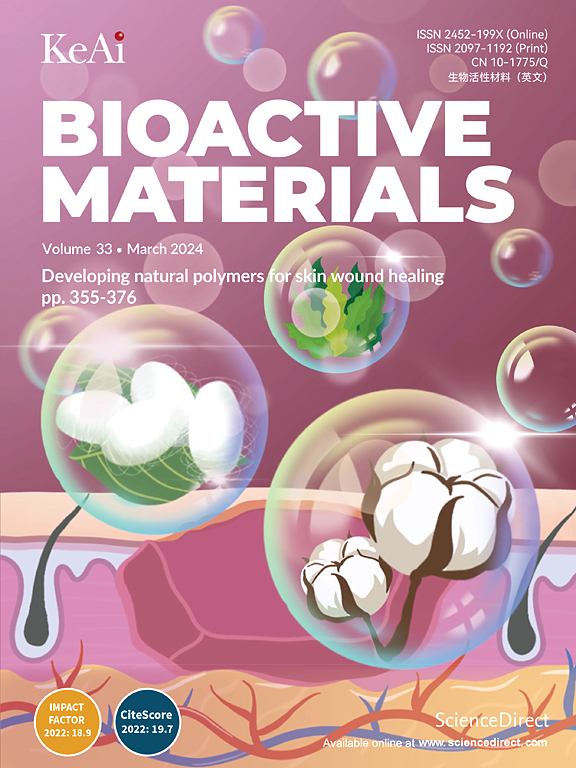Regulating macrophage glucose metabolism homeostasis via mitochondrial rheostats by short fiber-microsphere scaffolds for bone repair
IF 18
1区 医学
Q1 ENGINEERING, BIOMEDICAL
引用次数: 0
Abstract
The alterations in glucose metabolism flux induced by mitochondrial function changes are crucial for regulating bone immune homeostasis. The restoration of mitochondrial homeostasis, serving as a pivotal rheostat for balancing glucose metabolism in immune cells, can effectively mitigate inflammation and initiate osteogenesis. Herein, an ion-activated mitochondrial rheostat fiber-microsphere polymerization system (FM@CeZnHA) was innovatively constructed. Physical-chemical and molecular biological methods confirmed that CeZnHA, characterized by a rapid degradation rate, releases Ce/Zn ions that restore mitochondrial metabolic homeostasis and M1/M2 balance of macrophages through swift redox reactions. This process reduces the glycolysis level of macrophages by down-regulating the NF-κB p65 signaling pathway, enhances their mitochondrial metabolic dependence, alleviates excessive early inflammatory responses, and promptly initiates osteogenesis. The FM network provided a stable platform for macrophage glycolytic transformation and simulated extracellular matrix microenvironment, continuously restoring mitochondrial homeostasis and accelerating ossification center formation through the release of metal ions from the internal CeZnHA for efficient bone immune cascade reactions. This strategy of bone immunity mediated by the restoration of macrophage mitochondrial metabolic function and glucose metabolic flux homeostasis opens up a new approach to treating bone defects.

短纤维微球支架通过线粒体变阻器调节巨噬细胞葡萄糖代谢稳态用于骨修复
线粒体功能改变引起的糖代谢通量的改变对调节骨免疫稳态至关重要。线粒体稳态的恢复,作为平衡免疫细胞中葡萄糖代谢的关键变阻器,可以有效地减轻炎症和启动成骨。本文创新性地构建了离子激活线粒体变阻器纤维-微球聚合体系(FM@CeZnHA)。物理化学和分子生物学方法证实CeZnHA具有降解速度快的特点,通过快速氧化还原反应释放Ce/Zn离子,恢复巨噬细胞线粒体代谢稳态和M1/M2平衡。该过程通过下调NF-κB p65信号通路降低巨噬细胞糖酵解水平,增强其线粒体代谢依赖性,减轻过度的早期炎症反应,并迅速启动成骨。FM网络为巨噬细胞糖酵解转化和模拟细胞外基质微环境提供了稳定的平台,通过内部CeZnHA释放金属离子,不断恢复线粒体稳态,加速骨化中心形成,实现高效的骨免疫级联反应。巨噬细胞线粒体代谢功能和糖代谢通量稳态恢复介导的骨免疫策略为骨缺损的治疗开辟了一条新的途径。
本文章由计算机程序翻译,如有差异,请以英文原文为准。
求助全文
约1分钟内获得全文
求助全文
来源期刊

Bioactive Materials
Biochemistry, Genetics and Molecular Biology-Biotechnology
CiteScore
28.00
自引率
6.30%
发文量
436
审稿时长
20 days
期刊介绍:
Bioactive Materials is a peer-reviewed research publication that focuses on advancements in bioactive materials. The journal accepts research papers, reviews, and rapid communications in the field of next-generation biomaterials that interact with cells, tissues, and organs in various living organisms.
The primary goal of Bioactive Materials is to promote the science and engineering of biomaterials that exhibit adaptiveness to the biological environment. These materials are specifically designed to stimulate or direct appropriate cell and tissue responses or regulate interactions with microorganisms.
The journal covers a wide range of bioactive materials, including those that are engineered or designed in terms of their physical form (e.g. particulate, fiber), topology (e.g. porosity, surface roughness), or dimensions (ranging from macro to nano-scales). Contributions are sought from the following categories of bioactive materials:
Bioactive metals and alloys
Bioactive inorganics: ceramics, glasses, and carbon-based materials
Bioactive polymers and gels
Bioactive materials derived from natural sources
Bioactive composites
These materials find applications in human and veterinary medicine, such as implants, tissue engineering scaffolds, cell/drug/gene carriers, as well as imaging and sensing devices.
 求助内容:
求助内容: 应助结果提醒方式:
应助结果提醒方式:


